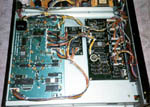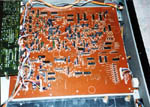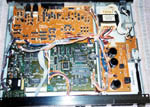 |
|
resemblence to a real piano, but is still in use by many techno and country artists, as well as pop icons like Elton John. Roland's subsequent releases lacked some of the flavor and sound of the original MKS/RD |
|
sound generation boards are identical sans ROMs. The real difference in sound between units is due to the chorus board. The MKS-20 features a gargantuan analog chorus board, while the P-330 features an effects board 1/3 the size and with 1/5 the active components. The P-330's strength lies in its smaller size and lighter weight, as well as better display and patch storage. Still, the MKS-20 is my favorite and is still in my rack. |
| [MKS-20 Digital Board]The Roland MKS-20 has long been a staple of musicians, touring acts, and session players worldwide. The MKS-20 (as well as the keyboard versions, the RD-300 and RD-1000) was the first responsive non-sampled digital piano to replace the Yamaha CP70/CP80, as well as the real thing. Roland used a proprietary synthesis method to recreate the sound of a real piano. Fifteen years later the MKS-20's sound seems to bear little |
 |
| [MKS-20 Chorus Board]
series. I recently disected my Roland MKS-20 and P-330, and have provided pictures and details of their innards. The MKS-20 digital control board differs from the control board in the P-330, however the |
 [P-330 Boards]
[P-330 Boards]
|
|
  |
|
 |
|
  |


